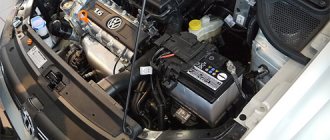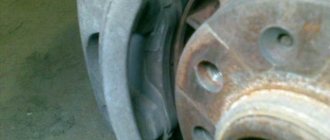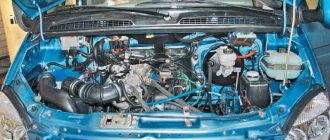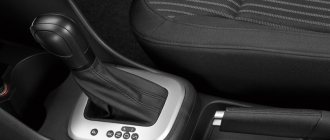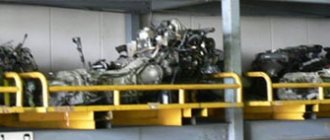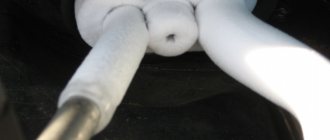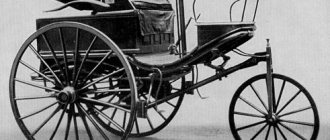The Volkswagen Polo sedan engine, which we will talk about today, will be produced directly in Russia in 2020, at the new Volkswagen engine plant. True, the timing chain will be replaced with a belt, and the power of the unit will increase by 5 horsepower. In addition to the Polo sedan, a 1.6-liter gasoline engine is now installed in the larger Jetta, Skoda Octavia and Rapid models. The 1.6-liter power unit, the most popular among our customers, is produced in two versions with a capacity of 85 and 105 hp. with 16 valves (factory designation CFNB and CFNA, respectively). The difference between the 85 horsepower version and the 105 horsepower modification of the Volkswagen Polo engine lies in the design features of the cylinder head and the presence (or absence) of a variable valve timing system. Naturally, due to the presence of a timing system, the 105 strong version is more powerful, dynamic and economical. First, let's talk about the more powerful engine of the Polo sedan.
So, the Polo 1.6 16V engine has the factory name CFNA. It is a gasoline, four-stroke, 4-cylinder, in-line, 16-valve, two-camshaft engine. Under the hood it stands transversely. The operating order of the cylinders is: 1-3-4-2, counting from the crankshaft pulley. The engine power supply system of the Volkswagen Polo sedan is phased distributed fuel injection. The engine is mounted on three elastic rubber-metal supports. The right mount is hydraulic; it is attached to a bracket attached to the timing cover, and the left and rear engine mounts are attached to brackets on the gearbox housing.
Characteristics
The cylinder block of the Volkswagen Polo engine is aluminum, the cylinder head is also aluminum, and the engine sump is also made of aluminum alloy. In the 16-valve version, the spark plugs are screwed into the top center of the combustion chamber. Timing chain drive . The chain in the engine makes the Polo sedan 1.6 unit very reliable and durable. In addition, the cylinder head contains hydraulic compensators that automatically regulate the thermal clearance of the valves. The engine is very sensitive to oil quality. Underfilling of oil and its reduced level can lead to rapid wear of the hydraulic compensators.
The Polo sedan 1.6 engine has a system of continuously variable valve timing of the intake valves, which makes the engine flexible in all operating ranges. The engine has a contactless ignition system with four coils. The entire operation of the power unit is controlled by an electronic control unit (the brains of the motor). An electronic system controls fuel distribution. The dosed working mixture is supplied to the cylinders through the throttle assembly in accordance with the valve timing. Below are detailed characteristics of the Volkswagen Polo 1.6 16V CFNA engine .
Service
Timely maintenance of the Volkswagen Polo sedan engine significantly extends its service life and allows it to be increased to 500 thousand kilometers.
Basically it comes down to regular computer diagnostics and replacement (after every 15 thousand km of travel):
- motor oil;
- oil filter;
- oil pan plugs.
In addition, every 30,000 km it is recommended:
- replace the air filter;
- Pay attention to the spark plugs and replace them if necessary.
This is interesting: A professional driver is pleased with the weather and bonuses
Engine VW Polo sedan 1.6 16V (gasoline) characteristics, fuel consumption, dynamics
- Working volume – 1598 cm3
- Number of cylinders – 4
- Number of valves – 16
- Cylinder diameter – 76.5 mm
- Piston stroke – 86.9 mm
- Power hp/kW – 105/77 at 5600 rpm
- Torque – 153 Nm at 3800 rpm
- Compression ratio – 10.5
- Type timing/timing drive – DOHC/chain
- Fuel brand – gasoline AI 95
- Ecological class – Euro-4
- Maximum speed – 190 km/h
- Acceleration to 100 km/h – 10.5 seconds
- Fuel consumption in the city – 8.7 liters
- Combined cycle - 6.4 liters
- Fuel consumption on the highway - 5.1 liters
Above are the dynamic characteristics and fuel consumption of a Polo sedan with a manual transmission; with an automatic transmission these figures are worse. So, acceleration to hundreds with automatic transmission takes 12.1 seconds, and fuel consumption increases by half a liter of gasoline.
What is a DOHC engine? Features, design, advantages and disadvantages
Today we will find out what is called a car engine with a DOHC gas distribution system , what is the principle of operation and what is the difference between the engine and other types of power plants
. WHAT IS A DOHC ENGINE. FEATURES, DESIGN, ADVANTAGES AND DISADVANTAGES
Good afternoon, today we will find out what is called
car
engine
with
DOHC gas distribution system
,
what is the principle of operation
and
what is the difference between the engine
and other
types
of power plants.
In addition, we will tell you about the features
and
design
of
an engine
with
a DOHC system
,
which relates
to its
advantages
and
disadvantages
, as well as
how repairable an engine
of this
type
.
In conclusion, we’ll talk about which modern
cars
have an engine
with
a DOHC system
,
what main components the engine consists of
, and
whether
a power plant with
two gas camshafts
is beneficial operation
and
maintenance .
Almost every motorist has at least once seen under the hood
of this or that car, how beautifully and proudly
the abbreviation
-
DOHC
.
But not every car enthusiast knows what it means. The abbreviated concept DOHC stands
for
Double Over Head Camshaft
, that is, it means that in the power plant
at the top of the gas distribution system
located
above the cylinder block
there are
2 separate camshafts
.
“
DOHS
system , as auto mechanics call it, is equipped with
two shafts
, one of which comes with
a cam
.
When
the camshaft
and
cam rotate, it opens the valves
that
the engine
for
its operating stroke
, that is, for
the intake of the fuel-air mixture
and
the release of exhaust gases
.
For reference, we note that the predecessor of
this
engine
in the automotive industry was
the SOHC system
, which
stands
for
Single Over Head Camshaft
, that is,
an engine equipped with one
single
camshaft
.
WHAT IS ENGINE CYLINDER HONING
WHAT IS AN ENGINE OVERHAUL
So what
Still, in a more
detailed concept,
what is
a DOHC gas distribution system
?
Engines equipped with a DOHC
, in addition to being
equipped with 2 camshafts in
the
cylinder head
, as a rule, also have
4 valves
per
cylinder
, that is, in most cases such power plants come with a
total number of valves
of
16 units
.
An engine of this type is often marked
, for example
2.0 DOHC 16v
, where
the first numbers
are
the engine volume
, then
the name of the gas distribution system
and
the total number of valves
(
not per cylinder, but total
).
For reference, we note that the very concept of DOHC
came to us from Western European countries, or more precisely from
France
and
Italy
.
It is believed that the ancestor of the SOHC system
, the predecessor
of DOHC
, was
Fiat
and its
car models
According to
For most car owners,
the
DOHC
gas distribution system is more
popular
and
common
than
the SOHC
, since
engine
efficiency
is much better with
two camshafts and
cams
than
with
one .
Note that both shafts are driven by a belt
or chain
drive
, which comes from
the crankshaft
of the power plant.
As we noted earlier, the gas distribution system of a DOHC
equipped with
4 valves
per
cylinder
, but there are also other
modifications
.
In addition to 4 valves
per
cylinder
there are also
engine models
equipped with
from 2 to 5
or even more
valves
per
cylinder
.
But such gas distribution systems
are considered more
experimental
and very rare.
1. Features, design and principle of operation of engines with the DOHC system
Design feature
All
engines
with
a DOHC gas distribution system
is that
the camshaft
is located directly
above each row of valves
in the power plant, that is,
above the intake
and
exhaust
.
In addition, such a system
completely
devoid of intermediary parts
, such as
rods
, various
rockers
and
rocker arms
.
In order to
each
valve
as light as possible , the manufacturer decided
to install
not
2
, but
4 valves
on
the cylinder , and
lightweight ones
.
Thus, if the engine speed increases
by
1.5 times
,
the system
springs will bear significantly
less load
.
In addition, thanks to two small-diameter intake valves,
1.5 times more combustible mixture
will enter the
cylinder than if there were
one
, but
large one
.
Thus, the combustible mixture
, based on such
a specific design of engine components,
will
burn more efficiently
in
the cylinder chambers
, and
the efficiency
of increase .
Also note that in order to
drive
the 2 camshafts
,
a toothed belt
,
a set of gears
or
a chain
are often used the cylinder head .
If we take into account the drive belt
, then it, as
a consumable item
is quite
cheap
,
does not require lubrication
and
operates almost silently
.
However, unlike
a chain
, if
the timing belt breaks
, this will immediately mean “
death
”
to the valves
and
pistons of the engine
, and then a beautiful exit to
the capital of the engine
.
Why is this happening?
Because
the valve hits
the
piston
and their “
friendly meeting
” occurs, that is,
the destruction of two parts
, and
the cylinder liner
and
the block
.
Therefore the chain
It looks much
more reliable
and
durable than a belt
, but at the same time it is
noisier
in
operation
.
the
system chain
is
its
gradual pulling and stretching
.
Chain stretching
by tightening
it during routine
maintenance
.
Also, the chain
, unlike
the
belt
, needs
a sealed housing
, since
it operates
in
an oil
“
mist
”.
As for the next type of gas distribution drive system
-
a set of gears
, this
element
is quite
expensive
to
maintain
and excessively
noisy
when
the engine is running
, but
the most reliable
.
You should also not forget about such an indicator
of any power plant as
the compression ratio
.
Dec here, the higher the compression ratio of the engine
, the
greater
its
efficiency
.
And this is not even surprising, since most modern engines operate
with
high compression ratios
.
That is why the most optimal shape of the combustion chamber
of a power plant is
a spherical segment
.
it is not always possible to manufacture
such a combustion chamber compromise
in
production
.
This is done in order to make a spherical combustion chamber
on
one side
and at the same time try to maintain
a cone-shaped shape
on
the other side
.
this shape
by
reducing the angle
between
the intake
and
exhaust valves of the engine
.
Thus, we get the following picture: we increase the compression ratio
by
reducing the angle
between
the valves
.
In order for the engine
to produce
the highest efficiency
with
4 valves
per
cylinder
, it is also necessary
to change the location of the spark plugs
, which in
engines
with
a DOHC system
are located in
the combustion chamber
, and in its
center
.
Specially created long channels
increase
the height of the cylinder heads
, and therefore
the spark plugs
quite
deep
in
the wells .
When replacing
these
consumables
a special
spark plug wrench
.
In addition to the specific location of the spark plugs
power plants with
a DOHC gas distribution system
have another
feature
, which is
the presence of
a special
hydraulic lash compensator
.
This component
is located between
the rear of the valve
and
the tappet
.
The task of the lash adjuster
is
to supply engine oil
under
pressure
from
the lubrication system
.
,
this gap
for
DOHS
engines
varies
depending on whether
the engine is cold or
hot ,
and whether
the valve seat is worn out
or
not
.
2. Advantages and disadvantages of power plants with DOHC gas distribution system
The advantages of
engines
with
a DOHC gas distribution system
include the fact that all
engine forces are distributed equally
across
two shafts
and due to this,
the power
of the installation
by about 10-25 horsepower
.
In addition, the dynamic operation of engine systems improves
, which ultimately makes it possible
to reduce oil consumption
, and if
hydraulic compensators
are also used the engine , this allows, in addition,
to reduce the noise
from
the operation
of the power plant.
In addition to increasing power
and
reducing engine noise
the smoothness of
also improves ,
the engine runs without
any
vibrations
, as if
evenly
.
Also, the advantages of the DOHC system
often include the fact that the power plant becomes able to
spin up quickly
,
acquires
better acceleration characteristics
and overall
dynamics .
The disadvantages
of a gas distribution system
with
2 camshafts
primarily include
the complexity of the design
.
This difficulty
lies in
regulating the components of the gas distribution system
and therefore this affects the overall
maintainability of the engine
.
Thus, servicing
a power plant with
a DOHC system
will be
more expensive
SOHC
predecessor with
a 1st camshaft
.
The shortcomings
there and we move on to
the nuances
that are also important to consider when
operating
and
servicing
such
engines
.
Power plants with
the DOHS
system , which are additionally
equipped with hydraulic compensators
, require exclusively
synthetic motor oils
of very
high quality
, as well as their
frequent replacement
.
In addition to the points described above, it is also necessary to take into account the fact that the system
“
DOHC
” requires
periodic adjustment of valve clearances
.
To adjust
, you need to
remove the camshafts
,
change the valve timing
, and also
select the thickness of the adjusting washers
, which
are located
between
the pusher
and
the knuckle
.
And then you need to reassemble
engine
components
measure the gap
again , and if you can’t
find
, then again you will need to
disassemble
.
Video: “What is a DOHC engine. Features, design, advantages and disadvantages”
In conclusion, we note that if we compare all the positive aspects related to power plants with the DOHC system and the negative aspects that increase their cost of operating the engine, then we can conclude that these engines definitely have the right to exist. All additional costs incurred during the operation of the engine can be almost completely compensated by good fuel economy and very expressive dynamics of the power plant. Also
For reference, we note that in recent years, engines with the DOHC system have been increasingly installed in their cars by Korean and Japanese manufacturers, using the example of Kia, Hyundai, Toyota and Honda.
THANK YOU VERY MUCH FOR YOUR ATTENTION. LEAVE YOUR COMMENTS AND SHARE WITH YOUR FRIENDS. WE ARE WELCOME TO YOUR FEEDBACK AND SUGGESTIONS.
A simpler motor
A simpler engine in the VW Polo sedan 1.6 without a variable valve timing system on the intake shaft did not appear immediately, but after the manufacturer had to reduce the price of the car in the fight for customers. A simplified version of the Polo sedan engine made the car a little cheaper, but the car's power also dropped. This engine has the factory index CFNB. The chain mechanism remains, but the cylinder head is now in a simplified form without an actuator for stepless timing change.
The 85 horsepower Polo sedan engine is installed only in combination with a manual transmission. A new power unit appeared in the company’s lineup in Russia only in the middle of last year. This is why there is not much information about the detailed structure and design of the engine, but the main characteristics are known.
What's under the hood
Sales of the new Volkswagen Polo began in September 2010. Much water has passed under the bridge since then, and some nuances in the operation of a car engine have become clear. Volkswagen is equipped with one engine with 110 horsepower. A feature of the equipment is considered to be increased oil consumption. This phenomenon is observed when the vehicle is run in within 1-1.5 thousand km. At this time, constant monitoring of oil availability is necessary. At the same time, drivers note that its level does not decrease below the minimum mark.
A huge advantage of the VR6 engine installed on Volkswagen is the chain drive of the gas distributor. It is characterized by a long service life, so complete wear will not occur soon. Car enthusiasts do not recommend feeding your car with low-quality gasoline. If the recommendation is ignored, certain problems with the engine may occur. It is also noted that in severe frost (more than -25 degrees), the Polo may refuse to start, which is explained by incorrect operation of the starter.
Boxes Polo Sedan
The Polo Sedan is equipped with a five-speed manual transmission or a six-speed Tiptronic automatic transmission. Transmissions have proven themselves in terms of reliability, but in the domestic market the version with manual transmission is more common. The manual transmission contains 2 liters of oil, which is advisable to change if you bought a car from the secondary market with a mileage of more than 100 thousand km. After all, lubricant tends to become dirty and lose its basic properties. The automatic uses 7 liters of ATF, and the working fluid must be replaced every 80 thousand km.
To extend the life of a mechanical transmission, we recommend using the RVS-Master Transmission Tr3 composition. This is a friction geomodifier that restores working surfaces and protects them from future wear. Thanks to the use of the composition, it will be possible to minimize the amount of noise and vibration, extend the life of the manual transmission, and achieve easy and precise gear shifting.
The RVS-Master Transmission Atr7 additive is suitable for a six-speed automatic transmission. It forms a cermet layer on the contact parts, thereby eliminating wear and characteristic kicks when switching.
note
A serious nuisance can be called knocking under the hood when driving on uneven roads. If the car suspension and steering rack are in order, then the left engine mount is faulty. It very often does not withstand stress and requires replacement.
To extend the service life, fill only high-quality fuel with an octane number of at least 95 into the CFNA engine - problems of unstable operation, jerking and jolting will then bypass you. In cases of difficulty starting in severe frost, inspect the starter.
A common problem is the appearance of cracks in a standard exhaust manifold. Defects can be detected if you pay attention to changes in the sound of the engine. The malfunction is eliminated by installing a more modern “spider” 4-1 or 4-2-1 with simultaneous reinstallation of the ECU software.
A budget solution to this problem can be argon arc welding. But you can only use it after the warranty has expired, otherwise you will lose the right to service.
